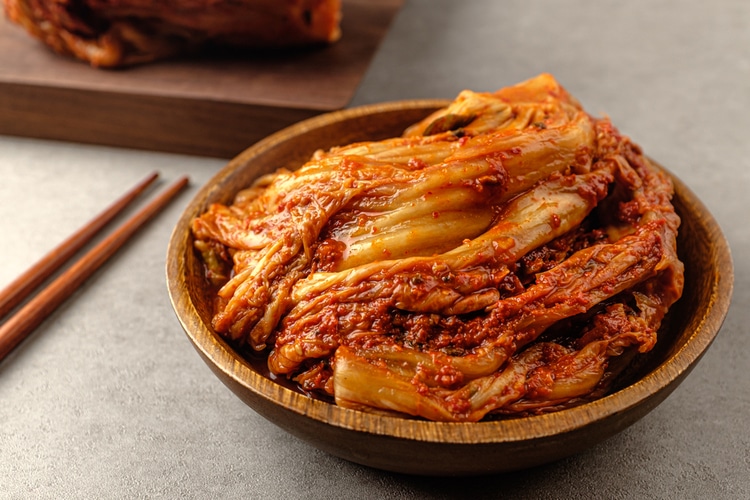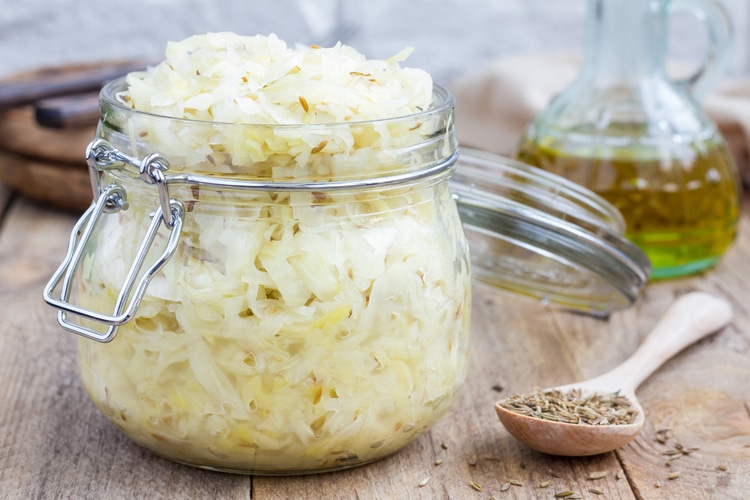Kimchi and sauerkraut are foods made by pickling cabbage leaves and other vegetables with lactobacillus—lactic acid bacteria.
Both happen to be gluten-free and chocked full of probiotics. Although they look very similar, the flavor profiles are much different.
These two items can be used interchangeably just as long as you’re aware of how the change will affect the overall flavor of your dish. There are some apparent differences.
Difference Between Kimchi and Sauerkraut
The main difference between kimchi and sauerkraut is the taste. Kimchi tends to have a broader range of flavors, from sour to spicy to salty. Traditional sauerkraut is sour and pungent.
Additional differences include:
Seasonings: Kimchi can include multiple spices like ginger, salt, garlic, spring onions, chili peppers, and jeotgal. Sauerkraut, on the other hand, only uses salt.
Appearance: With kimchi, the cabbage leaves are usually whole or chunked, but sauerkraut is finely shredded cabbage leaves.
Ingredients: Kimchi includes cabbage and can also contain carrots, radishes, spinach, scallions, celery, and cucumbers. Sauerkraut uses green or red cabbage.
Taste: Kimchi can be spicy, slightly sweet, or salty, but sauerkraut is acidic and tart.
Kimchi vs Sauerkraut Comparison Table
| KIMCHI | SAUERKRAUT |
| Originated in Korea | Originated in China |
| Made using whole cabbage leaves or chunks of cabbage, but can also incorporate other vegetables including radishes, cucumbers, carrots, spinach, celery, or scallions | Made using only finely shredded cabbage |
| Ferments for one to two days | Ferments for five days to two weeks |
| Crunchy | Crunchy |
| Can be spicy, sour, or salty based on the ingredients and spices used | Pungent (tart and acidic) |
| Uses a variety of seasonings including ginger, chili peppers, garlic, salt, jeotgal, and spring onions | Uses salt and sometimes caraway seeds |
Can You Substitute Kimchi for Sauerkraut?
Because sauerkraut is a fermented cabbage dish and condiment, it’s a great substitute for kimchi.
Also, Sauerkraut is lightly seasoned, which makes a good alternative for kimchi, which is on the milder side.
To get the sauerkraut to fit kimchi’s flavor profile a bit more, you’ll want to add some vinegar and salt. Typically, kimchi is saltier than sauerkraut.
However, if you wish to substitute sauerkraut for the hotter versions of kimchi, add some Korean chili paste or Korean chili flakes to reproduce the umami and spice that you find with authentic kimchi.
If you do not have access to Korean chili products, you can use cayenne pepper and Thai fish sauce to achieve a similar flavor profile. You are much more likely to find sauerkraut in European-influenced food cultures, and it will almost always be cheaper than kimchi.
Fortunately, because kimchi and sauerkraut have a close enough flavor profile, you can use either as a straight substitute for the other.
Here are some tasty recipes to try out: Spicy Kimchi Slaw, Kimchi Fried Rice, or you can use the ingredient as a side or a condiment in a stew, on a hot dog, etc.
What is Kimchi?

Kimchi is a Korean food made using fermented veggies. Moreover, the dish is prepared using various seasonings, including ginger, chili peppers, garlic, salt, jeotgal, and spring onions.
When it comes to vegetables, cabbage is the most common vegetable used in kimchi; however, you can use vegetables such as cucumber, radish, celery, spinach, scallions, and carrot.
Moreover, there are different kimchi recipes, and it all depends on the veggies, spices, and the regions in which they are prepared.
You can make kimchi from home very easily—most of the work involves fermenting or pickling. It may take a bit of time to prepare the spices and the ingredients, and the fermentation process will also take time.
Generally speaking, kimchi has sour, spicy, and umami flavors. However, achieving these flavors has a lot to do with the chosen vegetables and the number of seasons used, including the length of the fermentation process.
On another note, kimchi lasts very long and, for this reason, is very economical and practical to make.
Kimchi Fermentation Process
The fermentation process takes place because billions of probiotics are added to allow for the lactobacillus bacteria cultures to eat at the carbs, which releases lactic acid.
Probiotics are very helpful to your gut and aids in restoring balance to your gut bio, which can boost your overall immune system.
Furthermore, probiotics are known to be beneficial for both diarrhea and fevers. Be mindful that the benefits are not instantaneous, meaning that you’ll need to consume kimchi regularly to receive its full benefits.
The best way to reap all of the benefits of kimchi is to regularly incorporate it into your diet.
Kimchi contains probiotics that can help boost the immune system’s ability to fight off infections. While you can’t use kimchi alone as a treatment, it may be a part of a healthy diet that works to keep your digestive system functioning optimally.
How to Use Kimchi
They serve kimchi as a side dish with nearly all meals in Korea. It’s also sometimes used as an appetizer or a component of another dish. For example, Koreans typically use kimchi with fried rice, sandwiches, noodles, stews, stir-fry, and so on.
You can even slice kimchi and add it to a hotpot dish or soup, or chop it up and sprinkle it as a garnish. Some people prefer to create kimchi from whole cabbage leaves so that they can use them like a wrap for shellfish, fish, and other meats.
If you decide to make kimchi on your own, try replicating a recipe that uses larger cabbage chunks or leaves because it yields the most predictable results. The thinly sliced kimchi can be a little harder to master at first.
Having trouble finding Kimchi? Read our article on where to find kimchi at the grocery store.
What is Sauerkraut?

While we associate sauerkraut with Germany and deem it a German delicacy, it was actually first used in ancient China some 2,000 years ago.
Sauerkraut is a form of fermented cabbage that uses salt and chopped cabbage mixed. It takes several weeks for the fermentation process, during which the cabbage releases the lactic acid that gives sauerkraut its signature sour flavor.
Sauerkraut is easy to make because you can just chop up the raw cabbage into fine slices, add salt, and pack it up in a container to stay put for a while.
A key area that differentiates between kimchi and sauerkraut concerning how easy they are to make is the extra seasonings used in kimchi. If you make the slices too thin, it can be harder not to over-season it because you’re using a variety of spices.
With sauerkraut, it’s just salt, and you have more room because the flavor profile is somewhat limited. When you put the cabbage in the brine (salt), the good bacteria on the surface begin to transform the sugar into lactic acid.
Think of it like natural preservation. Depending on how much cabbage you’re using, it can take several days to several weeks, but it gradually gets more crunchy and sour over time.
Do not wash the cabbage before starting this process because you’ll remove the bacteria needed to turn it into sauerkraut.
Billions of probiotics in sauerkraut will restore the balance in your gut, and good bacteria is a fantastic defense against toxins and other harmful bacteria. You can notice a reduction in Issues like bloating, gas, and other gut issues immediately.
Sauerkraut Benefits
Sauerkraut contains a lot of vitamin C and iron, which promotes faster healing and a healthier immune system. Similar to kimchi, if you want to take advantage of the health benefits of sauerkraut, it’s best to eat it regularly.
Sauerkraut has an abundance of dietary fiber, making you feel satiated for longer. This factor limits the number of extra snacks and meals you would otherwise consume if you didn’t feel full.
Kraut also has low carbs, so it’s a great food to add to your diet if you’re trying to support your weight loss goals. It is also easy to find, as you can get sauerkraut at the nearest grocery store.
How to Use Sauerkraut
Sauerkraut is one of the most popular side dishes in Germany. You can find different variations of sauerkraut, depending on what region of Germany you visit.
Some alternative ways of cooking this ingredient include kraut with apple, caraway seeds, or even shredded carrots.
Other ways to use this ingredient are as a side to a larger meal, as a guacamole topping, as a garnish on your scrambled eggs, atop your avocado toast, or added to your roasted potatoes.
Sauerkraut is fantastic as a dip, in a rice bowl, or on your sandwich and bratwurst or sausage, which is the way it’s commonly eaten in Germany.
Often, you eat sauerkraut raw, but that doesn’t mean that you can’t cook it first when you use it in any of the ways mentioned above. However, it will change the texture from crunchy to soft.
There are a variety of different uses of sauerkraut, and it can be used in numerous recipes- both in traditional German recipes and in some Chinese recipes as well.
If you need to store sauerkraut, you can do so by freezing sauerkraut for 4 – 6 months.







Which kraut is better for you ? Kimchi or Sauerkraut ?
Thank You
John Bonargo
Hi John, thanks for the interesting question. They are both excellent choices for a diet, so it’s hard to go wrong with either of them. If you look at classic recipes for each, however, kimchi has more vegetable ingredients that makes for more nutrition per serving. So, if you wanted the most versatility and nutrition, I would suggest kimchi is the winner. That said, you’ll likely find in your grocery store (especially in better ones) a wide variety of products that take kimchi and sauerkraut to exciting new flavor and ingredient areas that quickly blurs the lines between the two!